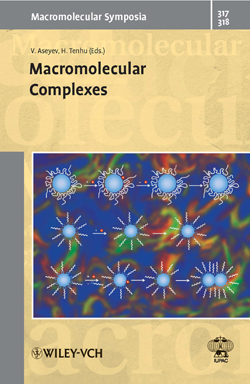|
Vol.
35 No. 1
January-February 2013
Macromolecular complexes, whether they are interpolymeric ones or polymers complexed with low-molar-mass organic molecules, metal ions, or particles participate in all fundamental aspects of life. They are as essential to the function of living organisms as to the development of new functional materials.
 |
Of interpolymeric complexes, those formed by polyelectrolytes are among the most complicated ones when it comes to the factors affecting their formation and structure, as well as their properties under various conditions and the influence of stimuli from the surroundings. Polyelectrolyte complexes mediate the essential processes involved in the functions of living cells. The number of technological applications of charged polymers bound to each other is immense, ranging from water purification to cosmetics, biopharmaceutics, and medicine. An impressive example of the use of polyelectrolyte complexes was the treatment of contaminated soil around the Chernobyl nuclear reactor after the catastrophic disaster in 1986. This example demonstrated the dynamic nature of the complexes, which in this case where used to bind ions and glue contaminated soil into a solid crust.
Polyelectrolyte complexes also show properties of polyampholytes. Interpolymeric complexes may also build up due to stereochemical factors or via host-guest interactions. Cyclodextrins and calixarenes are known structural motifs, which may be utilized in host-guest complex formation and in building macromolecular complexes in a controlled manner.
Various aspects of the complexes between macromolecules and metals have been studied for several decades. Mechanisms of the complex formation, as well as the structures of the complexes are an important research problem as such, but detailed knowledge of all these factors is needed for application of the materials as catalysts and photoactive and electrically conducting materials. Macromolecular complexes are promising materials for high-performance energy devices. There are several examples of the use of macromolecular metal complexes in cancer therapy. Because macromolecules may be tailored to contain several functionalities they may be used to bind various toxic metals or organic substances from water. Owing to the remarkable advances in the methods of polymer synthesis, functional polymers can be used in advanced applications such as controlled drug delivery or as carriers of active substances from magnetic nanoparticles to human growth factors.
Controlled methods of polymer synthesis have accelerated the growth of diversity of compounds based on macromolecular complexes. Dendrimers and hyperbranched polymers, as well as polymeric brushes, comprise one important aspect in developing new materials. Both advanced synthesis methods and theoretical knowledge are needed for the creation of materials with specific properties. Another fast-growing research area closely related to macromolecular complexes is that of hybrid nanocomposites. Recent advances in nanoparticle technologies have opened a new field of complex composite materials based on gold, silver, or silica nanoparticles.
This volume includes papers based on presentations made at the 14th IUPAC International Symposium on Macromolecular Complexes (MMC-14) held in Helsinki, Finland, 14–17 August 2011. See conference report in March-April 2012 CI, p. 26.
http://dx.doi.org/10.1002/masy.201290022
Page
last modified 7 January 2013.
Copyright © 2003-2013 International Union of Pure and Applied Chemistry.
Questions regarding the website, please contact [email protected] |